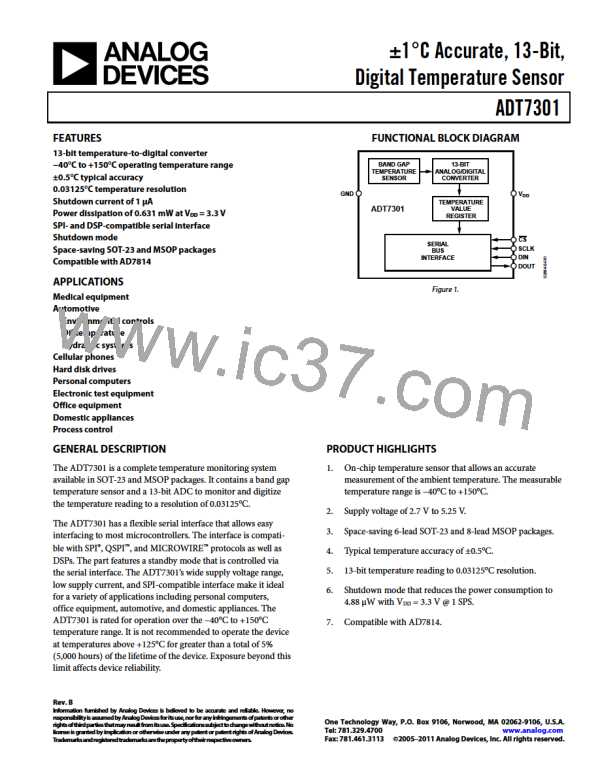ADT7301
ABSOLUTE MAXIMUM RATINGS
Table 3.
Stresses above those listed under Absolute Maximum Ratings
may cause permanent damage to the device. This is a stress
rating only; functional operation of the device at these or any
other conditions above those indicated in the operational
section of this specification is not implied. Exposure to absolute
maximum rating conditions for extended periods may affect
device reliability.
Parameter
Rating
VDD to GND
−0.3 V to +7 V
−0.3 V to VDD + 0.3 V
−0.3 V to VDD + 0.3 V
−40°C to +150°C
−65°C to +150°C
150°C
Digital Input Voltage to GND
Digital Output Voltage to GND
Operating Temperature Range1
Storage Temperature Range
Junction Temperature
6-Lead SOT-23 (RJ-6)
Power Dissipation2
1.2
1.0
0.8
3
WMAX = (TJ max − TA )/θJA
Thermal Impedance
θJA, Junction-to-Ambient
(Still Air)
190.4°C/W
SOT-23
8-Lead MSOP (RM-8)
Power Dissipation2
Thermal Impedance4
θJA, Junction-to-Ambient
(Still Air)
θJC, Junction-to-Case
IR Reflow Soldering
Peak Temperature
Time at Peak Temperature
Ramp-Up Rate
0.6
3
WMAX = (TJ max − TA )/θJA
MSOP
0.4
0.2
0
205.9°C/W
43.74°C/W
220°C (0°C/5°C)
10 sec to 20 sec
3°C/s max
TEMPERATURE (°C)
Figure 3. Plot of Maximum Power Dissipation vs. Temperature
Ramp-Down Rate
−6°C/s max
Time 25°C to Peak Temperature
IR Reflow Soldering—Pb-Free Package
Peak Temperature
6 minutes max
ESD CAUTION
260°C (0°C)
Time at Peak Temperature
Ramp-Up Rate
20 sec to 40 sec
3°C/s max
Ramp-Down Rate
−6°C/s max
Time 25°C to Peak Temperature
8 minutes max
1 It is not recommended to operate the ADT7301 at temperatures above
125°C for greater than a total of 5% (5,000 hours) of the lifetime of the
device. Any exposure beyond this limit affects device reliability.
2 Values relate to the package being used on a standard 2-layer PCB. Refer
to Figure 3 for a plot of maximum power dissipation vs. ambient
temperature (TA).
3 TA = ambient temperature.
4 Junction-to-case resistance is applicable to components featuring a
preferential flow direction, for example, components mounted on a heat
sink. Junction-to-ambient resistance is more useful for air-cooled,
PCB-mounted components.
Rev. B | Page 5 of 16

 TI [ TEXAS INSTRUMENTS ]
TI [ TEXAS INSTRUMENTS ]